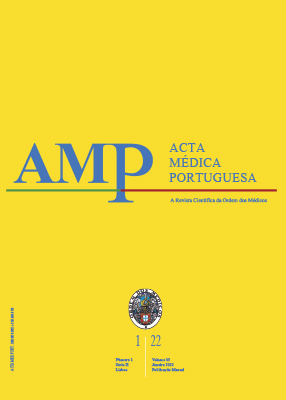Hemorragia Peri-Intraventricular Grave em Prematuros: Impacto na Mortalidade e no Neurodesenvolvimento aos 24 Meses
DOI:
https://doi.org/10.20344/amp.12295Palavras-chave:
Cérebro/diagnóstico por imagem, Deficiências do Desenvolvimento/diagnóstico por imagem, Hemorragia Cerebral Intraventricular, Recém-Nascido de Muito Baixo PesoResumo
Introdução: A hemorragia peri-intraventricular grave tem sido associada a maior mortalidade e sequelas do neurodesenvolvimento.
Mantém-se controverso o impacto da hemorragia peri-intraventricular isolada, sem lesão da substância branca. O objetivo deste trabalho foi avaliar a influência da hemorragia peri-intraventricular grave, associada ou não a leucomalácia peri-ventricular quística, na mortalidade e no neurodesenvolvimento aos 24 meses.
Material e Métodos: Estudo de coorte retrospetiva que incluiu os recém-nascidos com hemorragia peri-intraventricular grave, internados numa maternidade de apoio perinatal diferenciado, entre 2006 e 2015, e dois controlos com a mesma idade gestacional, internados logo a seguir ao caso, sem hemorragia peri-intraventricular. A avaliação do neurodesenvolvimento, aos 24 meses, foi realizada em 99 crianças, com recurso à escala The Schedule of Growing Skills Scale II em 52 e à escala de desenvolvimento mental de Ruth Griffiths em 47 crianças. Considerou-se défice grave do neurodesenvolvimento: paralisia cerebral, atraso do desenvolvimento psicomotor, surdez com necessidade de prótese auditiva ou cegueira.
Resultados: Foram incluídos 41 recém-nascidos com hemorragia peri-intraventricular grave e 82 controlos. Ocorreram 23 óbitos, 16 (39,0%) nas hemorragias peri-intraventricular graves e sete (8,5%) nos controlos (OR 7,6; IC 95% 2,6 - 20,4; p < 0,001). Verificou-se défice grave do neurodesenvolvimento em sete (30,4%) no grupo de hemorragia peri-intraventricular graves e um (1,3%) no grupo de controlos (OR 32; IC 95% 3,7 - 281; p < 0,001). Na análise individualizada, a mortalidade foi superior quer nas hemorragia peri-intraventricular grau III com leucomalácia peri-ventricular quística associada (OR 4,4 IC 95% 1,3 - 14,2; p = 0,015), quer na hemorragia peri-intraventricular grau IV (OR 12; IC 95% 3,5 - 41,2; p < 0,001), em relação aos controlos. Verificaram-se também diferenças no défice grave do neurodesenvolvimento em relação aos controlos (1,3%) na hemorragia peri-intraventricular grau III com leucomalácia peri-ventricular quística associada (75,0%, p < 0,001) e na hemorragia peri-intraventricular grau IV (50,0%, p < 0,001).
Discussão: Este estudo evidenciou maior taxa de mortalidade e de alterações graves do neurodesenvolvimento nos prematuros com hemorragia peri-intraventricular grave. A análise dos grupos estratificados por idade gestacional e a abordagem separada dos vários tipos de hemorragia peri-intraventricular, permitiu evidenciar as complicações associadas à hemorragia peri-intraventriculargrau IV e grau III, associada ou não a leucomalácia peri-ventricular quística.
Conclusão: Os recém-nascidos com hemorragia peri-intraventricular de grau IV ou grau III com leucomalácia peri-ventricular quística associaram-se a maior mortalidade e sequelas graves do neurodesenvolvimento.
Downloads
Downloads
Publicado
Como Citar
Edição
Secção
Licença
Direitos de Autor (c) 2020 Acta Médica Portuguesa

Este trabalho encontra-se publicado com a Creative Commons Atribuição-NãoComercial 4.0.
Todos os artigos publicados na AMP são de acesso aberto e cumprem os requisitos das agências de financiamento ou instituições académicas. Relativamente à utilização por terceiros a AMP rege-se pelos termos da licença Creative Commons ‘Atribuição – Uso Não-Comercial – (CC-BY-NC)’.
É da responsabilidade do autor obter permissão para reproduzir figuras, tabelas, etc., de outras publicações. Após a aceitação de um artigo, os autores serão convidados a preencher uma “Declaração de Responsabilidade Autoral e Partilha de Direitos de Autor “(http://www.actamedicaportuguesa.com/info/AMP-NormasPublicacao.pdf) e a “Declaração de Potenciais Conflitos de Interesse” (http://www.icmje.org/conflicts-of-interest) do ICMJE. Será enviado um e-mail ao autor correspondente, confirmando a receção do manuscrito.
Após a publicação, os autores ficam autorizados a disponibilizar os seus artigos em repositórios das suas instituições de origem, desde que mencionem sempre onde foram publicados e de acordo com a licença Creative Commons









